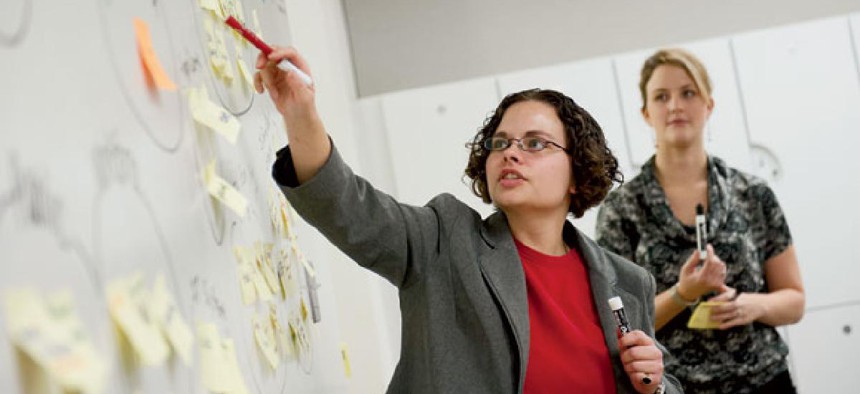To spark innovation, feds take a few lessons from Silicon Valley

OPM's Sarah Hassmer (left) and Cassie Cunfer facilitate a stakeholder mapping exercise in problem solving. James Kegley
OPM’s idea lab uses open spaces and human-centered design to foster collaboration on special projects.
Three years ago, officials from the Office of Personnel Management began visiting top Silicon Valley companies like Facebook and IDEO with one idea in mind: making government cool again. Now, OPM is embracing that cool factor by replicating some of the work habits and workspaces of those companies in designing an innovation lab in the sub-basement of its Washington headquarters.
“When we first visited these companies, we didn’t necessarily know we were going to build an innovation lab,” says agency spokesman John Marble. “We just knew that with the challenges we were facing that we needed to be more innovative in government.”
As part of the lab concept, OPM is embracing a practice already present in the private sector—human-centered design. It’s an innovative approach to problem solving that keeps the target audience in mind and could serve as a model for agencies looking to better serve taxpayers or other specific groups like veterans or federal workers, particularly when government is increasingly being asked to do more with less.
“The approach involves taking time on the front end to discover exactly what the problem is. And when you find that, it ends up saving money because you are applying resources to problems that you really do need to fix,” Marble says. “A lot of times, it’s like a math equation—you go in solving for X and realize you should have been solving for Y all along. It provides for better services in the end.”
Many top companies have combined human-centered design with workspaces that foster creativity and collaboration and can be manipulated depending on the specific project or challenge. For example, at IDEO, an innovation consulting firm, nearly every employee has swapped a personal cubicle or desk for an open workspace. Employees at Facebook have similar work areas as well as micro-kitchens, lounges, and trendy eateries and cafeterias. “Our belief is that the best ideas are not going to come from brainstorming in a conference room,” says Slater Tow, a spokesman at Facebook. “They’re going to come from two or three people sitting over lunch or dinner talking about how we can solve a problem.”
OPM incorporated those ideas into the design of its new $750,000 innovation lab, which boasts wheeled tables and chairs, whiteboards and chalkboard walls that can easily be rearranged as employees collaborate or break into groups to tackle projects. The hope is to re-create the “pressure cooker” environment of companies like Facebook, Marble says. “You walk into one of the open areas in Facebook and feel that pressure to actually produce,” he says. “We wanted to use the positive pressure of employees working together to achieve team results.”
OPM solicited employees to receive specialized training in human-centered design to facilitate sessions in the lab. Those 11 employees are all “naturally gifted facilitators,” and each of them perform those duties in addition to their regular full-time jobs, Marble says.
Projects require review by facilitators before employees are allowed to use the innovation space. The basic requirements are a “wicked” problem; a designated, diverse and/or cross-functional team; and a carefully planned agenda. A couple of groups from the Presidential Innovation Fellows program are based at the lab to work on governmentwide projects.
One work group is brainstorming ways to boost employee involvement in the health plan selection process during open season. The goal is to have more participants actively shopping among multiple plans, which would increase competition among plans and bring costs down.
OPM also is using the innovation lab to tackle challenges such as how to better train and integrate veterans into the federal workforce and finding a more efficient way to process service credit as part of employee retirement claims.
“It’s exciting to see the federal government take the time to listen beyond the Beltway and figure out what’s working throughout the country and incorporating that into Washington culture,” Marble says. “I think it makes us better serve the American public.”
Still, like any change in the federal government, creating a different workspace and collaborative process requires a culture shift. OPM is hoping to ease that shift simply by being transparent, in part by discussing the innovation lab at town halls for its employees and hosting open house tours of the workspace.
“One of the first things we did was destroy the notion of this ivory tower and actually build it as a place that is open to everyone at our agency,” Marble says.
The innovation lab already is having an impact on employees. Marble has seen examples of employees detailed from OPM and other agencies applying the principles they learned in the lab to projects in their own environment. “For workplaces no matter where they are—whether in the public or private sector—they tend to be static, so to see changes in work behaviors toward a more productive model is amazing,” he says.
But OPM cautions potential innovators not to view the lab as anything other than an enabler for collaborative, problem-focused work. That sentiment resonates with many of the lab’s Silicon Valley counterparts. “At the end of the day, it’s just a space,” says Yancy Widmer, director of experience at IDEO. “It’s more about the work and interaction that happens in it. But I also believe that the types of spaces you build and the experience you curate within that space are really fundamentally important to the work that actually happens there.”
Brittany Ballenstedt, a former staff writer for Government Executive, covers the IT workforce for Nextgov.
NEXT STORY: OPM extends application period for IT fellows



